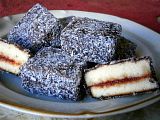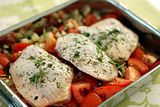
This wonderful loaf was baked thanks to Temperance the host of this november challenge. I 'm desperately running out of time so I made it in the bread machine (as I used a cup of my sourdough I turned off the machine to let it proof longer). I added some walnuts, pecans and raisins and 'substituted' sourdough for part of the white flour and water, I don't know why mine got so dark maybe too much cocoa ? Anyway the bread is very very delicious It's waiting for me for breakfast !!!
RECIPE
Old World Rye
A World of Breads by Dolores Casella, 1966
2 cups rye flour
1/4 cup cocoa
2 T yeast
1 1/2 cups warm water
1/2 cup molasses
2 tsp salt
2 T caraway seed
2 T butter
2 1/2 cups white flour or whole wheat flour
Combine the rye flour and cocoa. do not sift.
Dissolve the yeast in 1/2 cup warm water.
Mix molasses, 1 cup warm water, salt, and caraway seed in large mixing bowl.
Add the rye/cocoa mix, the proofed yeast, the butter and 1 cup white flour or whole wheat flour.
Beat until the dough is smooth.
Spread the remaining flour on a breadboard and kneed it into the dough
Add more flour if necessary to make a firm dough that is smooth and elastic.
Place in buttered bowl and cover. Allow to rise until double (about 2 hours).
Punch dough down, shape into a round loaf and place on a buttered cookie sheet that has been sprinkled with cornmeal.
Let rise about 50 minutes.
Bake at 375 for 35 to 40 minutes.
Notes:
You can add 1/2 cup brown sugar and 1 cup each of raisins and walnuts.
Don't limit yourself to round loaves, have fun.
And to prove that man CAN live by bread alone....
Back in the 1930's, a Cornell University professor named Clive McCay developed a bread recipe named Cornell Bread. It makes a complete protein that rats can live on exclusively. (The only reason that humans can't live on it exclusively is that it lacks vitamin C, which rats don't need.)
The Cornell formula to enrich bread consists of 1 tablespoon each soy flour and nonfat milk powder plus 1 teaspoon wheat germ for each cup of flour used in a bread recipe. These enrichments are placed in the bottom of the measuring cup before the flour is spooned in.
A World of Breads by Dolores Casella, 1966
2 cups rye flour
1/4 cup cocoa
2 T yeast
1 1/2 cups warm water
1/2 cup molasses
2 tsp salt
2 T caraway seed
2 T butter
2 1/2 cups white flour or whole wheat flour
Combine the rye flour and cocoa. do not sift.
Dissolve the yeast in 1/2 cup warm water.
Mix molasses, 1 cup warm water, salt, and caraway seed in large mixing bowl.
Add the rye/cocoa mix, the proofed yeast, the butter and 1 cup white flour or whole wheat flour.
Beat until the dough is smooth.
Spread the remaining flour on a breadboard and kneed it into the dough
Add more flour if necessary to make a firm dough that is smooth and elastic.
Place in buttered bowl and cover. Allow to rise until double (about 2 hours).
Punch dough down, shape into a round loaf and place on a buttered cookie sheet that has been sprinkled with cornmeal.
Let rise about 50 minutes.
Bake at 375 for 35 to 40 minutes.
Notes:
You can add 1/2 cup brown sugar and 1 cup each of raisins and walnuts.
Don't limit yourself to round loaves, have fun.
And to prove that man CAN live by bread alone....
Back in the 1930's, a Cornell University professor named Clive McCay developed a bread recipe named Cornell Bread. It makes a complete protein that rats can live on exclusively. (The only reason that humans can't live on it exclusively is that it lacks vitamin C, which rats don't need.)
The Cornell formula to enrich bread consists of 1 tablespoon each soy flour and nonfat milk powder plus 1 teaspoon wheat germ for each cup of flour used in a bread recipe. These enrichments are placed in the bottom of the measuring cup before the flour is spooned in.
























































































.jpg)













.jpg)





































